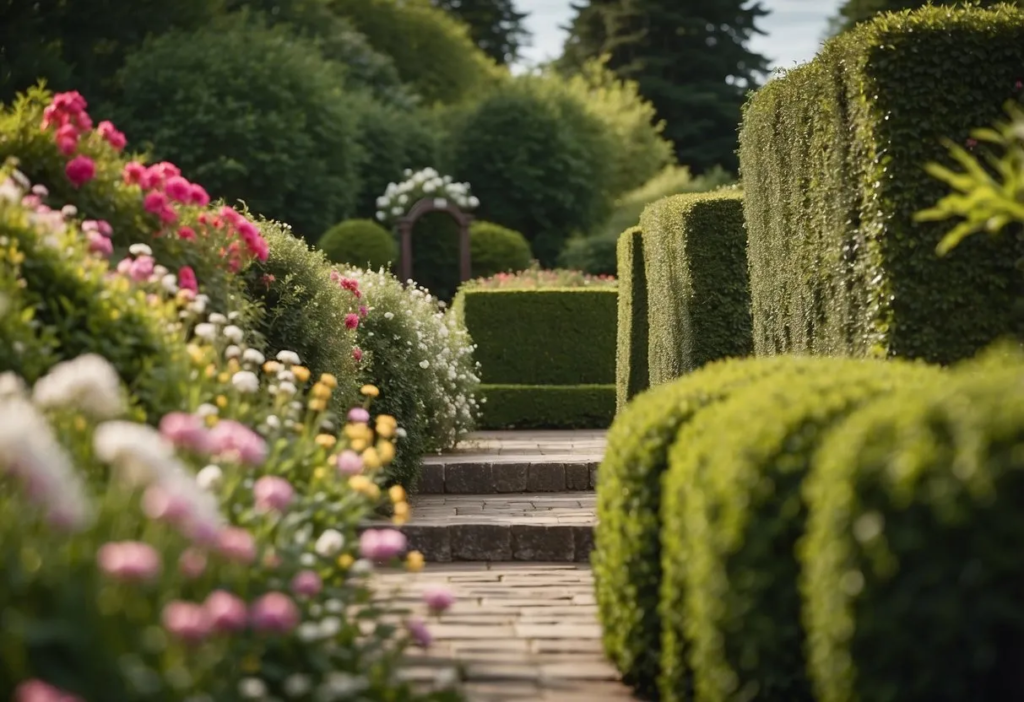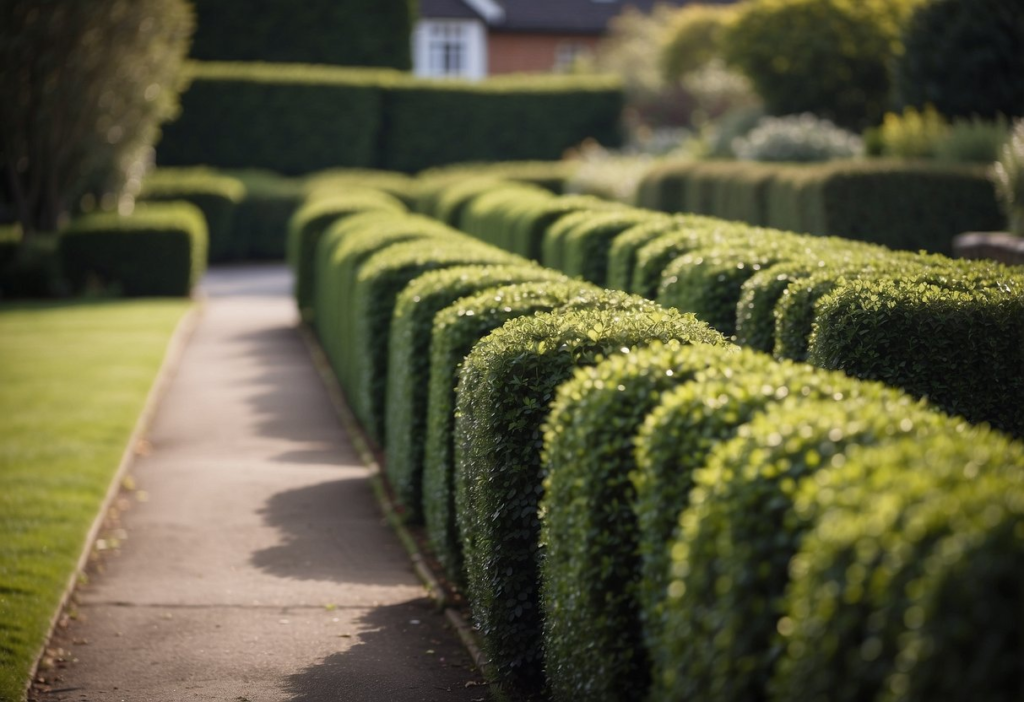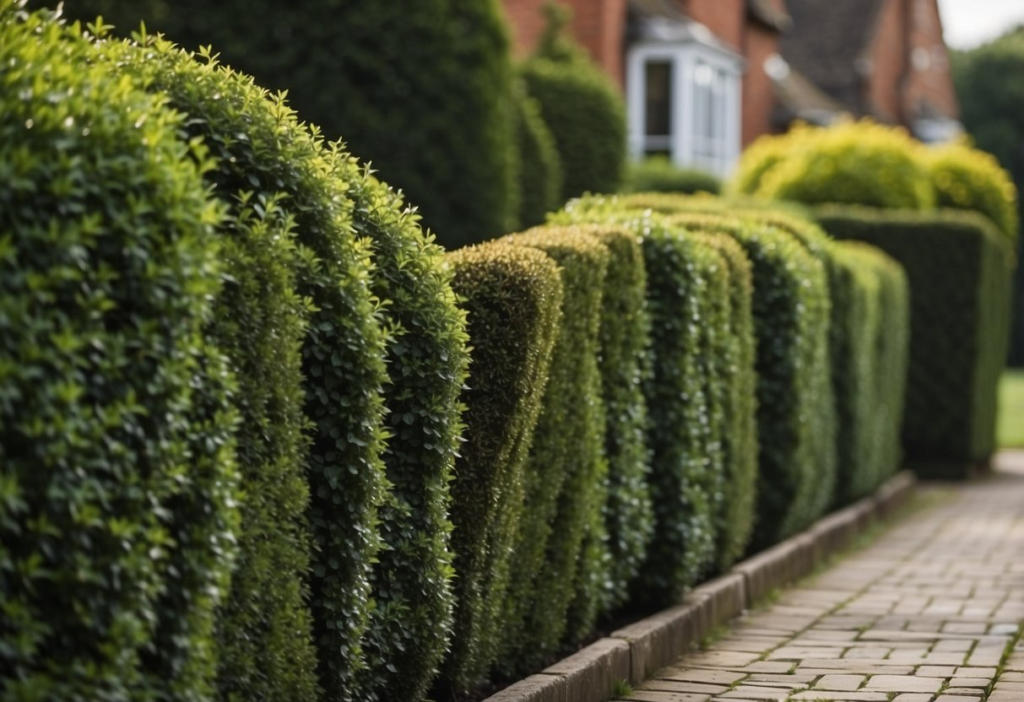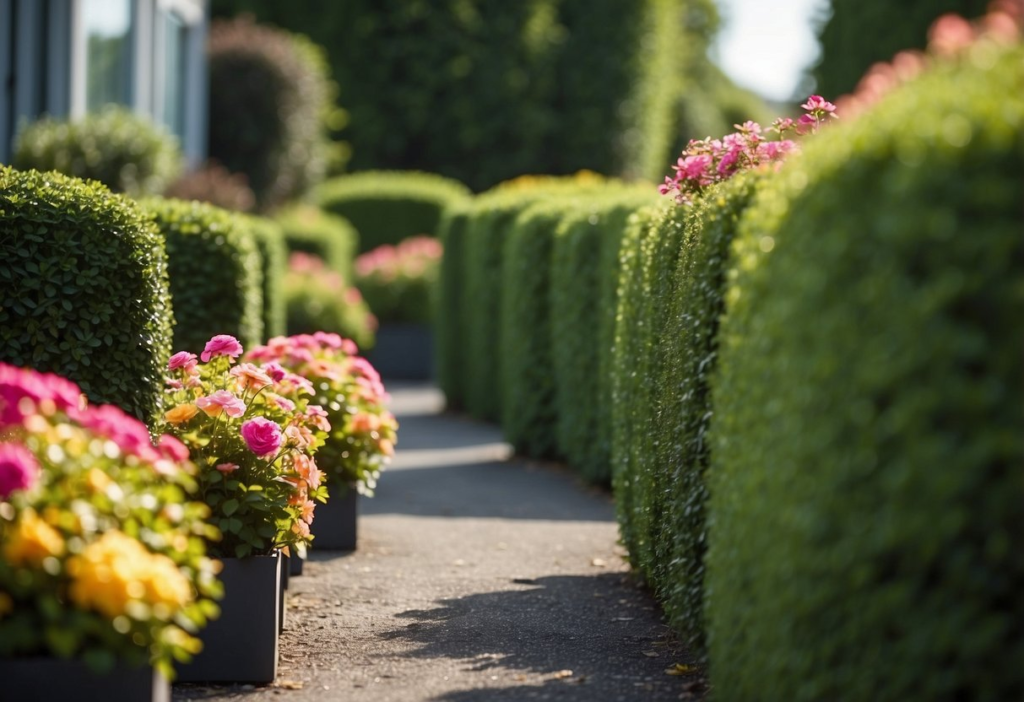
In the UK, are you considering improving the front of your house? Hedges are a great way to give your outdoor space some structure and seclusion. They give your yard a neat and inviting appearance by serving as a green backdrop for vibrant flowers and other garden accents.
Hedges provide advantages including wind protection and noise reduction in addition to being aesthetically pleasing. You will discover that there are a variety of styles and types available, each appropriate for varying garden sizes and individual preferences. There is a hedge that is ideal for your front garden, regardless of your preference for a more natural, informal appearance or a more formal, clipped appearance.
Boxwood Hedge (Buxus)

Boxwood (Buxus) is a beloved choice for front gardens, particularly in the UK, due to its classic, dense evergreen foliage. Its geometric form works beautifully across various garden styles, offering a timeless appeal.
You can utilize boxwoods to frame entrances or craft tidy, low hedges that outline garden beds. Their structured appearance is perfect for creating a formal and polished look.
Another effective use is planting boxwood mounds along pathways or steps. These rounded green shapes not only add a stylish element but also require minimal maintenance, needing only occasional trimming to keep their shape.
Yew Hedge (Taxus baccata)

A Yew Hedge (Taxus baccata) is an excellent choice for adding privacy and structure to your front garden. Its dense, columnar growth and dark green, needle-like leaves make it ideal for creating a secluded space.
Yew hedges are versatile, thriving in both sunny and shaded conditions. Once established, they require minimal watering. A summer trim will help maintain their tidy, upright appearance.
These hedges provide year-round cover and can even produce attractive red berry-like fruits, which are beneficial for local wildlife. Learn more about the benefits of Yew hedges at A guide to using Taxus Baccata for a hedge.
Privet Hedge (Ligustrum)

For a classic, elegant look, consider a privet hedge. Privet hedges are well-suited to a variety of UK climates and are known for their ease of growth in well-drained soil.
With consistent pruning, a privet hedge will retain its formal appearance. Be sure to check for bird nests before trimming. The evergreen nature of privet ensures your garden remains vibrant through the winter months.
Beech Hedge (Fagus sylvatica)

Beech hedges offer year-round interest with their ability to hold onto leaves throughout winter. Plant young beech plants 25-45 cm apart for a dense hedge, or use a double staggered row for quicker coverage.
These hedges grow up to 60 cm per year and thrive in well-drained soil with sun or partial shade. Beech hedges are long-lasting, making them a durable choice for your garden’s landscape. Discover more about beech hedging in this detailed guide.
Holly Hedge (Ilex aquifolium)

Consider a Holly hedge (Ilex aquifolium) if you’re looking for a hedge that combines privacy with a touch of traditional charm. Its dense, prickly foliage provides excellent security and a year-round green presence.
Holly is evergreen, offering continuous greenery, and female plants produce vibrant red berries in winter, attracting birds and enhancing garden appeal. Plant a male holly nearby to ensure berry production and enjoy a hedge that grows up to four or five meters, suitable for various garden sizes.
Laurel Hedge (Prunus laurocerasus)

The Laurel Hedge (Prunus laurocerasus) is a popular choice for UK front gardens, known for its glossy, dark green leaves that form a lush screen. It grows rapidly, reaching up to 60 cm per year, and can be maintained between 1-5 meters high.
For comprehensive tips on growing laurel hedges, explore this detailed guide.
Hornbeam Hedge (Carpinus betulus)

Hornbeam Hedge (Carpinus betulus) is ideal for creating a private and dense boundary. It starts as a slender tree and matures into a thick, full hedge with dark green foliage that turns yellow-orange in fall.
Space hornbeam plants about 60 cm apart for optimal growth. They can reach up to 80 feet tall in favorable conditions. Ensure the soil is well-drained and free from weeds to support their development. Learn more about hornbeam hedges for your garden.
Escallonia Hedge

An Escallonia hedge adds a vibrant touch to your front garden with its colorful blooms in pink, red, and white. These evergreen shrubs are particularly suited for coastal areas due to their tolerance of salty air and wind.
Escallonia grows quickly, adding 20-45 cm each year, and its dense foliage provides excellent privacy. The glossy leaves ensure the hedge remains attractive throughout the year.
Griselinia Hedge

Griselinia is a great option for UK front gardens, valued for its vibrant, glossy green leaves that stay green year-round. This hardy plant is perfect for adding color even in winter.
Plant Griselinia about 60 cm apart to establish a dense hedge quickly. For lower hedges, plant them closer together. Griselinia is also tolerant of salty air and strong winds, making it suitable for coastal regions. Check out these tips for growing and caring for Griselinia.
Photinia Red Robin Hedge

Photinia Red Robin is a striking choice for a front garden hedge, especially in the UK. Its spring shoots display a vivid red before maturing to lush green, adding vibrant color to your garden.
This evergreen shrub forms a dense screen throughout the year and features clusters of small white flowers in spring. Plant Photinia Red Robin about 75 cm apart for rapid growth and a lush hedge. Adjust spacing for larger plants to ensure optimal development.
Benefits of Front Garden Hedges

Front garden hedges offer numerous benefits, including enhanced privacy and security, aesthetic appeal, and support for local wildlife.
Privacy and Security
Hedges like cherry laurel create effective barriers between your home and the street, providing privacy and deterring intruders. Some hedges, such as Rosa rugosa, feature thorns that further enhance security. Additionally, hedges act as windbreakers, protecting your home from strong winds.
Aesthetic Appeal
Hedges can greatly enhance the visual appeal of your front garden. They introduce various colors, textures, and shapes, from the glossy evergreen leaves of cherry laurel to the seasonal blooms of Rosa rugosa. Hedges can also serve as borders to define different garden areas, creating a well-organized and attractive space.
Wildlife Support
Hedges are excellent for wildlife, offering shelter and nesting sites for birds and attracting beneficial insects like bees and butterflies. The berries and flowers of certain hedges provide food sources, supporting local ecosystems. By selecting the right hedges, you can create a thriving habitat for wildlife.
Choosing the Right Hedge for Your Garden

When selecting a hedge for your front garden in the UK, consider your local climate, maintenance needs, and desired growth rate and size.
Climate Considerations
Different hedges suit different climates. Cherry laurel is hardy and withstands harsh winters, while boxwood prefers milder conditions. Yew tolerates both shade and frost, making it a versatile choice. Choose a hedge that aligns with your area’s weather patterns to ensure optimal growth.
Maintenance Requirements
Consider how much time you can dedicate to hedge care. Privet and Photinia require regular trimming to maintain their shape, while cherry laurel and Holly are lower-maintenance options. Choose a hedge that fits your maintenance preferences to keep your garden looking its best.
Growth Rate and Size
Decide how quickly you want your hedge to grow. Boxwood grows slowly, ideal for low-maintenance hedges, while privet grows quickly, providing a fast privacy screen. Ensure the final size of the hedge suits your space, with options ranging from medium-sized hedges to tall, privacy screens.
